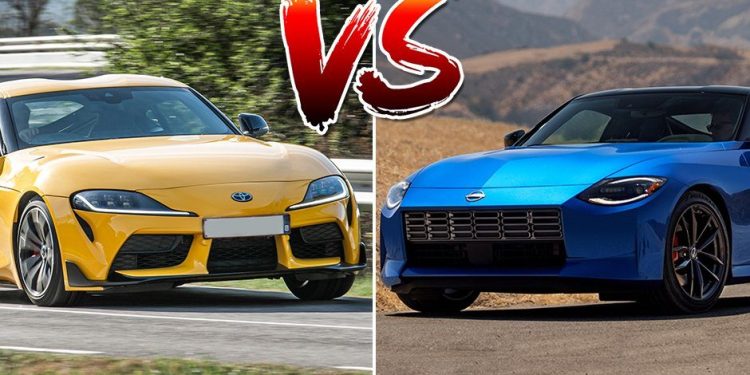Numbers war: Is the Nissan Z a match for the Toyota Supra?
Nissan’s newly revealed manual, rear-wheel drive, purists sports car Z comes at a time where the number of manual, rear-wheel drive, purist sports cars is on an absolute decline.
While the amount of natural rivals the new Zed has has clearly dwindled in recent years, it does have one clear benchmark to target in Toyota’s GR Supra. Yes, the Toyota doesn’t have a manual. But it sits fairly close to the Z on paper and given the shared Japanese origins between the two models, comparison is inevitable.
So, does the Supra have anything to worry about? Well, let’s see. The Supra comes with a 3.0-litre turbocharged inline six producing 285kW of power and 500Nm of torque. This powertrain is based on BMW’s B58 unit, an engine known for its tunability.

In our tests, the Supra has been able to hit 100km/h in a tick over four seconds flat (a smidge quicker than the claimed 4.1 seconds). Top speed, meanwhile, is electronically limited to 250km/h.
Although the Supra was much more potent than the outgoing 370Z when it first landed, it may have something to worry about with the new Z. It also uses a 3.0-litre six cylinder (in this case a V6 instead of a straight), however in this case forced induction comes via two turbochargers. Power is rated at 298kW (more than the Supra) and torque 475Nm (less).

Nissan hasn’t directly quoted a 0-100km/h or top speed for the Z, although it teases that it expects it to be some 15 per cent quicker to 100km/h than the 370Z, making for a potential 100km/h sprint time of 4.5 seconds.
While the Supra has the Nissan pinned on the theoretical timesheets, the rest of the numbers indicate a pretty tight battle in terms of grunt. Peak torque kicks in at around the same point in both cars, with peak power arriving a dash sooner in the Supra (5800rpm to the Z’s 6400rpm).
The similarities aren’t just based around the engines, either. Both get a torque-converter automatic instead of a dual-clutch (the Toyota’s is a ZF, we believe the Nissan’s is a Mercedes-Benz in-house 9G-Tronic).

Both are rear-wheel drive, both skip over the temptation for a big silly rear wing, and both also get notably diminutive wheelbase dimensions; 2470mm for the Supra and 2550mm for the Z. Amazing to think that the two sportsters both have less space between their axles than the Toyota 86 and Subaru BRZ.
The Z’s weight hasn’t been confirmed, but it’s estimated to tip the scales at around 1600kg in kerb weight. Price has also not been confirmed, although overseas reports indicate it’s likely to undercut the 1519kg (our official measurement), $99,290 GR Supra.

The shared focus on a tight wheelbase underlines that both marques are chasing similar handling characteristics. Each wants a car that rotates with glee. To that end it’s interesting to compare how they attack the matter of grip and control.
Rubber is an interesting mix. The Toyota comes standard on Michelin Pilot Super Sports with a slight stagger; 255/35 up front and 275/35 out back. While the base grade of Z has a comparatively dinky set of 245/45 Yokohama Advans all round, the Performance trim gets staggered Bridgestone Potenza 007s. Curiously they share the same contact patch as the Supra, but the fronts get a little more sidewall to play with; 255/40 front and 275/35 rear.

The advantage of coming second in a comparison like this is that you get an open-book on how your rival has done things. But Nissan has clearly done things differently in certain areas, too. It uses an aluminium double-wishbone front end as opposed to the Supra’s MacPherson strut set-up. Its limited-slip differential is mechanical, instead of being electric like the Supras.
Perhaps most different of all, though, is the philosophy of the platforms.

The Toyota is built on a BMW canvas. While being the more modern of the two platforms, it’s also been criticised by some for feeling much more like a BMW product than a Toyota product. The Nissan platform on the other hand is theirs through and through. Built on older carried-over bones, it nevertheless is something no other manufacturer has laid their fingers on.
The numbers as always only tell some of the story. Perhaps a real-world comparison between the two is in order, eh?





